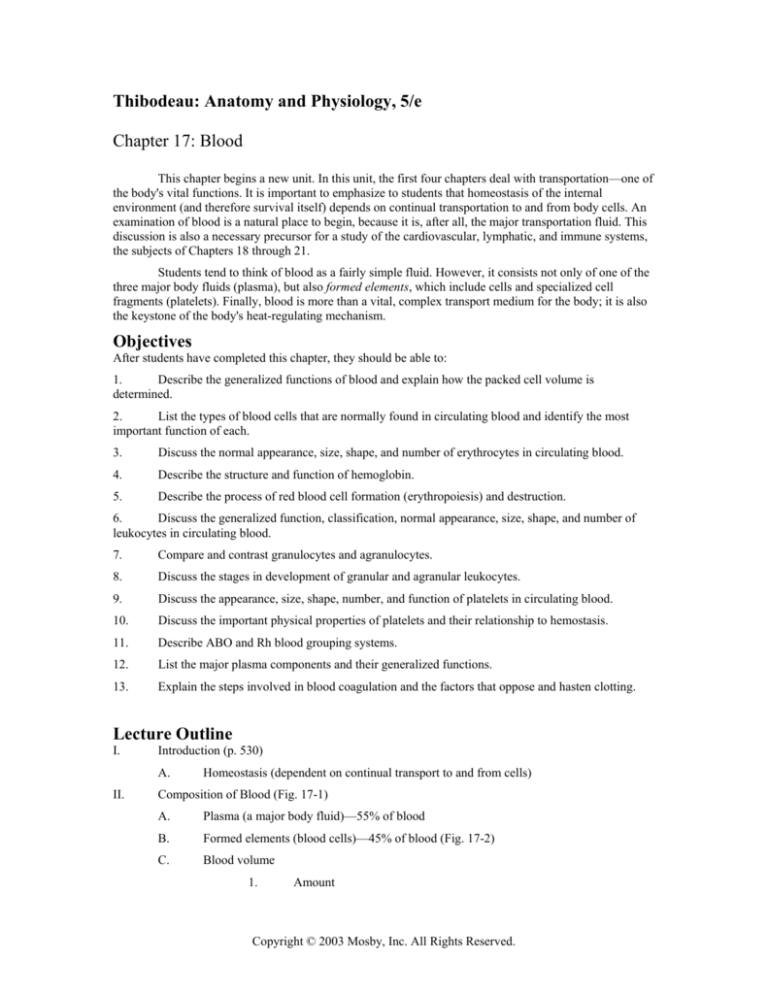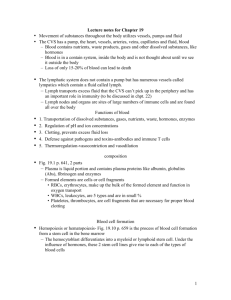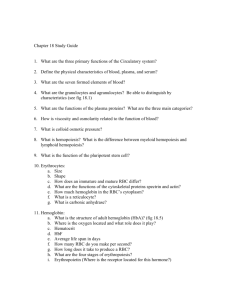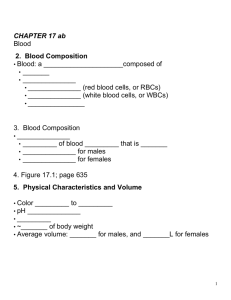
Thibodeau: Anatomy and Physiology, 5/e
Chapter 17: Blood
This chapter begins a new unit. In this unit, the first four chapters deal with transportation—one of
the body's vital functions. It is important to emphasize to students that homeostasis of the internal
environment (and therefore survival itself) depends on continual transportation to and from body cells. An
examination of blood is a natural place to begin, because it is, after all, the major transportation fluid. This
discussion is also a necessary precursor for a study of the cardiovascular, lymphatic, and immune systems,
the subjects of Chapters 18 through 21.
Students tend to think of blood as a fairly simple fluid. However, it consists not only of one of the
three major body fluids (plasma), but also formed elements, which include cells and specialized cell
fragments (platelets). Finally, blood is more than a vital, complex transport medium for the body; it is also
the keystone of the body's heat-regulating mechanism.
Objectives
After students have completed this chapter, they should be able to:
1.
Describe the generalized functions of blood and explain how the packed cell volume is
determined.
2.
List the types of blood cells that are normally found in circulating blood and identify the most
important function of each.
3.
Discuss the normal appearance, size, shape, and number of erythrocytes in circulating blood.
4.
Describe the structure and function of hemoglobin.
5.
Describe the process of red blood cell formation (erythropoiesis) and destruction.
6.
Discuss the generalized function, classification, normal appearance, size, shape, and number of
leukocytes in circulating blood.
7.
Compare and contrast granulocytes and agranulocytes.
8.
Discuss the stages in development of granular and agranular leukocytes.
9.
Discuss the appearance, size, shape, number, and function of platelets in circulating blood.
10.
Discuss the important physical properties of platelets and their relationship to hemostasis.
11.
Describe ABO and Rh blood grouping systems.
12.
List the major plasma components and their generalized functions.
13.
Explain the steps involved in blood coagulation and the factors that oppose and hasten clotting.
Lecture Outline
I.
Introduction (p. 530)
A.
II.
Homeostasis (dependent on continual transport to and from cells)
Composition of Blood (Fig. 17-1)
A.
Plasma (a major body fluid)—55% of blood
B.
Formed elements (blood cells)—45% of blood (Fig. 17-2)
C.
Blood volume
1.
Amount
Copyright © 2003 Mosby, Inc. All Rights Reserved.
Chapter 17: Blood
2
2.
a.
4–5 liters in females
b.
5–6 liters in males
c.
1 unit = about 0.5 liter
d.
Inversely related to amount of fat/kilogram
Measurement
a.
Direct method (only for experimental animals)
1)
b.
Indirect methods (used for humans)
1)
III.
Removal of all blood
Injection of known amount of RBCs tagged with
radioisotopes
Formed Elements of Blood (p. 531)
A.
Measurement of cells
1.
B.
Hematocrit—packed cell volume (PCV) (Fig. 17-3)
a.
Normal for males: 45%
b.
Normal for females: 42%
c.
Polycythemia
Red blood cells (erythrocytes) (Figs. 17-2, 17-4; Table 17-1)
1.
2.
Anatomy
a.
Nucleus absent
b.
Biconcave disk
c.
7.5 mm in diameter
d.
Filled with hemoglobin (Hb)
e.
Thin plasma membrane
f.
5,500,000/mm3 of blood in males
g.
4,800,000/mm3 of blood in females
Function of red blood cells (p. 533)
a.
3.
Hemoglobin (Hb) (Fig. 17-5)
a.
200 million to 300 million molecules/RBC
b.
4 oxygen molecules carried by each Hb molecule
c.
Normal Hb values:
d.
3.
Transport of oxygen and carbon dioxide
1)
Males: 14 g to 16 g/100 ml blood
2)
Females: 12 g to 14 g/100 ml blood
Anemia—less than 10 g/100 ml blood
Formation of red blood cells (erythropoiesis) (Figs. 17-6, 17-7)
a.
Hemopoietic adult stem cells (hemocytoblast) go through
stages to form erythrocytes
Copyright © 2003 Mosby, Inc. All Rights Reserved.
Chapter 17: Blood
3
b.
Stimulus for RBC formation is erythropoietin, produced
continually by liver
c.
Stimulus for increased RBC formation is low oxygen levels in
the kidney
1)
4.
C.
Destruction of red blood cells (Fig. 17-8)
a.
RBCs last about 120 days
b.
Macrophage cells in the liver and spleen phagocytose the old
cells
c.
Most components are recycled
White blood cells (leukocytes) (Fig. 17-2; Table 17-1)
1.
Granulocytes (granules in cytoplasm and lobed nuclei) (p. 538)
a.
Neutrophils: 65%–75% of total WBCs (Fig. 17-9)
1)
b.
c.
Lymphocytes: 20%–25% of total WBCs (Fig. 17-12)
1)
b.
Two types are important in the immune response
a)
Thymic lymphocytes (T lymphocytes, or T
cells)
b)
Bursal lymphocytes (B lymphocytes, or B
cells)
Monocytes: 3%–8% of total WBCs (Fig. 17-13)
1)
Become macrophages in the tissues
White blood cell numbers (Table 17-2)
a.
4.
Increase in numbers during allergic reactions and
periods of inflammation
Agranulocytes (no granules in cytoplasm and unlobed nuclei) (p. 536)
a.
3.
Increase in numbers during allergic reactions and
parasitic worm infections
Basophils: 0.5%–1% of total WBCs (Fig. 17-11)
1)
2.
Increase in numbers during acute infections
Eosinophils: 2%–5% of circulating WBCs (Fig. 17-10)
1)
D.
Erythropoietin stimulates the hemocytoblasts to
produce more RBCs
Normal: 5,000 to 9,000/mm3
Formation of white blood cells (Fig. 17-6)
a.
Hemopoietic adult stem cells (hemocytoblasts) go through
differentiation and then various stages to form each type of
WBC
b.
Red marrow tissue development for neutrophils, eosinophils,
basophils, and some lympho
cytes and monocytes
c.
Lymphoid tissue development for most lymphocytes and
monocytes
Platelets (thrombocytes) (Fig. 17-12)
Copyright © 2003 Mosby, Inc. All Rights Reserved.
Chapter 17: Blood
4
1.
2.
Characteristics
a.
150,000 to 350,000/mm3
b.
2 to 4 mm in diameter
c.
Plasma membrane-bound particles of cytoplasm containing
clotting factors
Functions of platelets
a.
Two roles:
1)
Hemostasis = stoppage of blood flow
a)
2)
3.
IV.
Platelet plug formed by platelets sticking
together (sticky platelets)
Coagulation = formation of fibrin clot (discussed
later)
Formation and life span of platelets (Fig. 17-6)
a.
Hemopoietic adult stem cells (hemocytoblasts) form
megakaryoblasts, which form megakaryocytes, which form
membrane-bound cytoplasmic fragments (platelets)
b.
Average survival about 7 days
Blood Types (Blood Groups) (p. 537)
A.
Definitions
1.
Blood type = type of agglutinogens present on the RBCs (Fig. 17-14)
a.
2.
Agglutinins (antibodies) (Fig. 17-14)
a.
3.
Plasma antibodies that cause agglutination of RBCs with
specific agglutinogens
Transfusion reactions (agglutination) (Fig. 17-16)
a.
B.
Agglutinogens are self-antigens
Reactions between agglutinogens and agglutinins of
noncompatable blood; causes the RBCs to agglutinate (stick
together)
The ABO system (Figs. 17-14, 17-15, 17-16)
1.
One of several blood type systems
2.
Type A
a.
3.
Type B
a.
4.
RBC has agglutinogens B; plasma has agglutinin anti-A
Type AB
a.
5.
RBC has agglutinogens A; plasma has agglutinin anti-B
RBC has agglutinogens A and B; plasma has no agglutinin
anti A or B
Type O
a.
RBC has no agglutinogens A or B; plasma has agglutinin antiA and B
Copyright © 2003 Mosby, Inc. All Rights Reserved.
Chapter 17: Blood
C.
5
The Rh system (p. 544)
1.
One of several blood type systems
2.
Type Rh-positive
3.
4.
V.
a.
RBC has a protein called Rh on its plasma membrane
b.
Plasma has no anti-Rh agglutinin
Type Rh-negative
a.
RBC has no Rh protein on its plasma membrane
b.
Plasma has no anti-Rh agglutinin
Erythroblastosis fetalis (Fig. 17-17)
a.
If mother is Rh-negative and has been exposed to Rh-positive
blood, her blood will have the anti-Rh agglutinin in the plasma
b.
If fetus is Rh-positive, mothers anti-Rh agglutinins will pass
through the placenta and cause agglutination of fetal
RBCs;this condition is called erythroblastosis fetalis
Blood Plasma (p. 545)
A.
Components (Fig. 17-1)
1.
91% water
2.
9% solutes
a.
Electrolytes
1)
b.
B.
Nonelectrolytes
1)
Proteins (7% of plasma)
2)
Nutrients
3)
Wastes
4)
Gases
5)
Regulatory substances (hormones, etc.)
Serum (Fig. 17-18)
1.
VI.
Sodium, chloride, potassium, etc.
The liquid of the blood without the clotting factors
Blood Clotting (Coagulation) (Fig. 17-19, 17-20)
A.
Mechanism of blood clotting (Fig. 17-21)
1.
Extrinsic clotting pathway
a.
2.
Intrinsic clotting pathway
a.
3.
Starts with damaged tissue and ends with production of an
enzyme—prothrombinase (prothrombin activator)
Starts with damaged endothelial cells contacting platelets and
ends with production of an enzyme—prothrombinase
(prothrombin activator)
Common clotting pathway
a.
Prothrombin activator converts prothrombin to thrombin
Copyright © 2003 Mosby, Inc. All Rights Reserved.
Chapter 17: Blood
6
b.
4.
Components (Fig. 17-21; Table 17-3)
a.
B.
C.
D.
VII.
VIII.
Thrombin is an enzyme that converts fibrinogen to fibrin for
the clot
Clotting factors listed in Table 17-3
Conditions that oppose clotting in intact vessels
1.
Smooth endothelium
2.
Presence of antithrombins (e.g., heparin)
Conditions that hasten clotting
1.
Rough places on endothelium
2.
Abnormally slow blood flow
Clot dissolution (fibrinolysis) (Fig. 17-22)
1.
Naturally occurring plasminogen can be activated to form plasmin,
which dissolves clots.
2.
Bacteria produce clot-dissolving chemicals to enhance their invasion;
these include streptokinase and t-PA, both of which have medical
applications
The Big Picture: Blood and the Whole Body (p. 549)
A.
Plasma links tissues of the body by transporting materials throughout the body to
maintain homeostasis
B.
Red blood cells transport oxygen and carbon dioxide
C.
White blood cells are important in the whole body's defense mechanisms
D.
Functions of blood depend on respiratory, endocrine, and urinary systems
E.
Blood must flow continuously to maintain stability
Mechanisms of Disease: Blood Disorders
A.
Red blood cell disorders
1.
2.
B.
Anemia = loss of total oxygen-carrying capacity by the RBCs due to
either a decrease of hemoglobin or a decrease in RBCs
a.
Aplastic anemia
b.
Pernicious anemia
c.
Folate deficiency anemia
d.
Acute blood-loss anemia
e.
Anemia of chronic disease
f.
Iron deficiency anemia
g.
Hemolytic anemia
1)
Sickle cell anemia
2)
Thalassemia
Polycythemia = excess of RBCs
White blood cell disorders
1.
Leukopenia: under 5,000 WBCs/mm3
Copyright © 2003 Mosby, Inc. All Rights Reserved.
Chapter 17: Blood
7
a.
2.
Leukocytosis: abnormally high WBC count—over 10,000 WBCs/mm3
a.
C.
Acquired immune deficiency syndrome (AIDS)
Leukemia
Clotting disorders
1.
2.
Excessive clotting
a.
Thrombus and thrombosis
b.
Embolus and embolism
Failure to clot
a.
Hemophilia
b.
Thrombocytopenia
Copyright © 2003 Mosby, Inc. All Rights Reserved.







